For owners of the 2009 Toyota 4Runner, maintaining your vehicle’s health is a top priority. One crucial aspect of this is monitoring the transmission fluid temperature, especially since these models come with a sealed transmission, lacking a traditional dipstick for easy checks. Knowing your transmission fluid temperature is vital for ensuring proper fluid level and preventing potential damage, particularly when performing maintenance or experiencing unusual driving conditions. While there are a few methods to achieve this, using an OBD2 scanner and the Torque Pro app offers a convenient and accurate solution. This guide will walk you through how to effectively monitor your 2009 Toyota 4Runner’s transmission temperature using OBD2 and the Torque Pro app, ensuring your vehicle runs smoothly and efficiently.
Checking the transmission fluid level on 2004 and later Toyota 4Runners, including the 2009 model, requires a specific procedure due to the sealed transmission design. Unlike older vehicles with dipsticks, these models need the fluid level to be checked at a specific temperature range. For instance, the factory service manual for a 2007 4Runner specifies a temperature range of 115°F to 130°F for A750E and A750F transmissions. It’s crucial to verify the exact temperature range for your 2009 4Runner’s transmission before proceeding with any fluid level checks. But how do you accurately monitor this temperature?
While some might suggest using an infrared thermometer pointed at the transmission pan, this method is widely considered inaccurate and unreliable. Professional technicians and experienced DIYers often avoid this approach due to its potential for misreading the actual fluid temperature. Instead, more precise methods are recommended to ensure accurate readings and proper maintenance.
Let’s explore two reliable methods for monitoring your 2009 Toyota 4Runner’s transmission fluid temperature. The first is a cost-effective but slightly more involved method using a paperclip and your vehicle’s dashboard lights. The second, and arguably easier method for regular monitoring, involves using an affordable OBD2 Bluetooth adapter and the Torque Pro app on your Android device. We will detail both methods to equip you with the knowledge to choose the best approach for your needs.
Method 1: The Paperclip Jumper Method for Transmission Temperature Check
For a budget-friendly approach, the Toyota Factory Service Manual outlines a method using a simple paperclip or jumper wire. This technique utilizes your 2009 Toyota 4Runner’s dashboard lights to indicate when the transmission fluid reaches the correct temperature range for checking the fluid level. This method requires starting with a cold transmission and observing the dashboard lights as the vehicle idles and warms up.
According to the factory service manual, this method involves using a jumper wire between terminals 4 and 13 of your 4Runner’s OBD port. Here are the steps detailed in the FSM for a 2007 4Runner, which are applicable to other Gen 4 models, including the 2009 Toyota 4Runner:
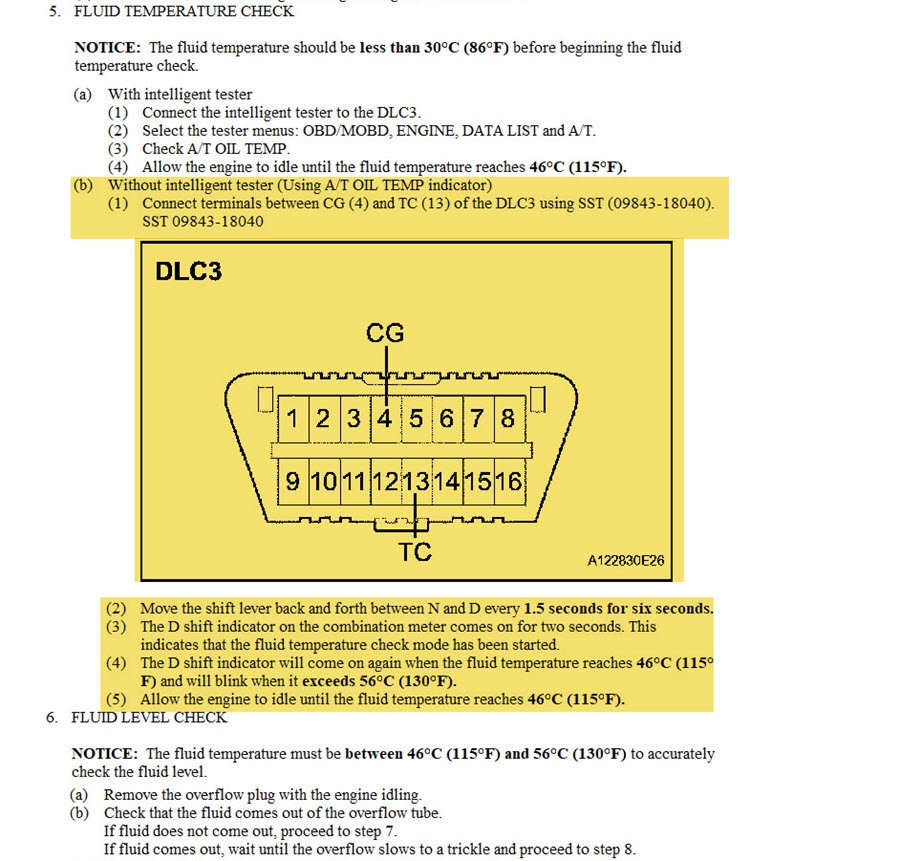 Diagram showing OBD port pinout for transmission fluid temperature check on a 4th Gen Toyota 4Runner
Diagram showing OBD port pinout for transmission fluid temperature check on a 4th Gen Toyota 4Runner
Factory Service Manual diagram illustrating the OBD port pinout for transmission fluid temperature check.
Steps for the Paperclip Method:
- Locate your OBDII port: Typically found under the dashboard on the driver’s side of your 2009 Toyota 4Runner.
- Prepare a jumper wire: A small paperclip works perfectly for this.
- Identify terminals 4 and 13: Refer to the diagram above or your vehicle’s service manual to correctly identify pins 4 and 13 in your OBDII port. Note that the OBD port might be oriented differently in your vehicle than in the manual’s illustration, but the pin locations remain the same.
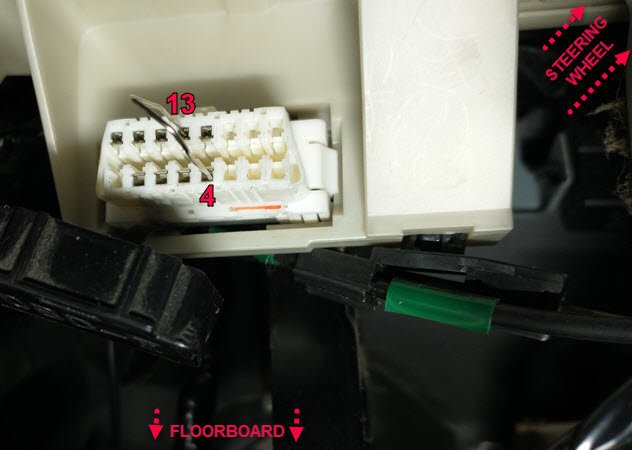 Image showing a paperclip jumper inserted into the OBD port of a Toyota 4Runner
Image showing a paperclip jumper inserted into the OBD port of a Toyota 4Runner
Close-up view of a paperclip jumper inserted into the specified pins of a Toyota 4Runner’s OBD port.
- Insert the jumper wire: Carefully insert the paperclip or jumper wire to connect terminals 4 and 13.
- Start the engine: Turn on your 2009 Toyota 4Runner’s engine. You will observe the dashboard lights flashing – this is normal and indicates the process has begun.
- Shift between Neutral and Drive: Shift the gear lever between Neutral (N) and Drive (D) every 1.5 seconds for a total of 6 seconds.
- Observe the indicator light: After this sequence, either the ‘D’ drive indicator or the ‘A/T Oil Temp’ light on your dashboard should illuminate for approximately 2 seconds and then turn off. This confirms that your vehicle has entered the Transmission Temperature Check Mode. On some 2009 4Runner models, the ‘A/T Oil Temp’ light is more likely to be the indicator.
 Dashboard A/T Oil Temp light illuminated in a Toyota 4Runner
Dashboard A/T Oil Temp light illuminated in a Toyota 4Runner
The ‘A/T Oil Temp’ light illuminated on the dashboard, indicating the transmission temperature check mode is active.
- Remove the jumper wire: Once the Transmission Temperature Check Mode is active, remove the paperclip jumper from the OBD port.
- Allow the engine to idle: Let the engine continue to idle. The transmission temperature will begin to rise.
- Monitor the indicator light again: Wait for the ‘D’ or ‘A/T Oil Temp’ light to illuminate and stay on continuously. This steady light indicates that the transmission fluid has reached the minimum temperature required for a fluid level check.
- Perform fluid level check: Immediately prepare to check the transmission fluid level. Have your tools and a catch pan ready. As soon as the light becomes steady, you have a window of opportunity to open the overflow check plug and confirm the fluid level before the light starts flashing, indicating the temperature has exceeded the maximum limit.
This method, while cost-free (excluding the paperclip!), can be a bit cumbersome and may require a practice run. It’s also often easier with two people, one to monitor the dashboard lights and another to be ready underneath the vehicle to check the fluid level as soon as the signal is given.
Method 2: Using OBD2 and Torque Pro App for Real-Time Temperature Monitoring
For a more user-friendly and versatile solution to monitor your 2009 Toyota 4Runner transmission temperature, consider using an OBD2 Bluetooth adapter and the Torque Pro app. This method, while requiring a small investment, offers real-time temperature readings directly on your Android device and can be used while driving, providing valuable insights, especially when towing or under heavy loads.
What you’ll need:
- ELM327 compatible OBDII Bluetooth dongle: These are readily available online for around $15-$30. A reliable option is the BAFX Products Android Wireless Bluetooth OBD2 Scanner.
- Torque Pro app: This app is available for a small fee (around $5) on the Google Play Store.
Setup and Configuration:
-
Connect the OBD2 dongle: Plug the OBD2 dongle into the OBDII port of your 2009 Toyota 4Runner.
-
Turn ignition to ‘ON’: Turn your key to the ‘ON’ position, but do not start the engine yet.
-
Pair Bluetooth: On your Android device, go to Bluetooth settings and pair with the OBD2 dongle. Refer to your dongle’s instructions for the device name if needed.
-
Set up Vehicle Profile in Torque Pro: Open the Torque Pro app and set up your vehicle profile if you haven’t already. This typically involves entering your vehicle’s year, make, and model.
-
Add Custom PID for Transmission Temperature: This is the crucial step to read the transmission temperature on your 2009 Toyota 4Runner.
- From the Torque Pro main screen, tap the gear icon (menu) > ‘Settings’ > ‘Manage extra PIDs/Sensors’.
- On the next screen, tap the menu button > ‘Add custom PID’ > ‘OK’.
- You will now enter the following custom PID data specifically for 4th Gen Toyota 4Runners (2004-2009):
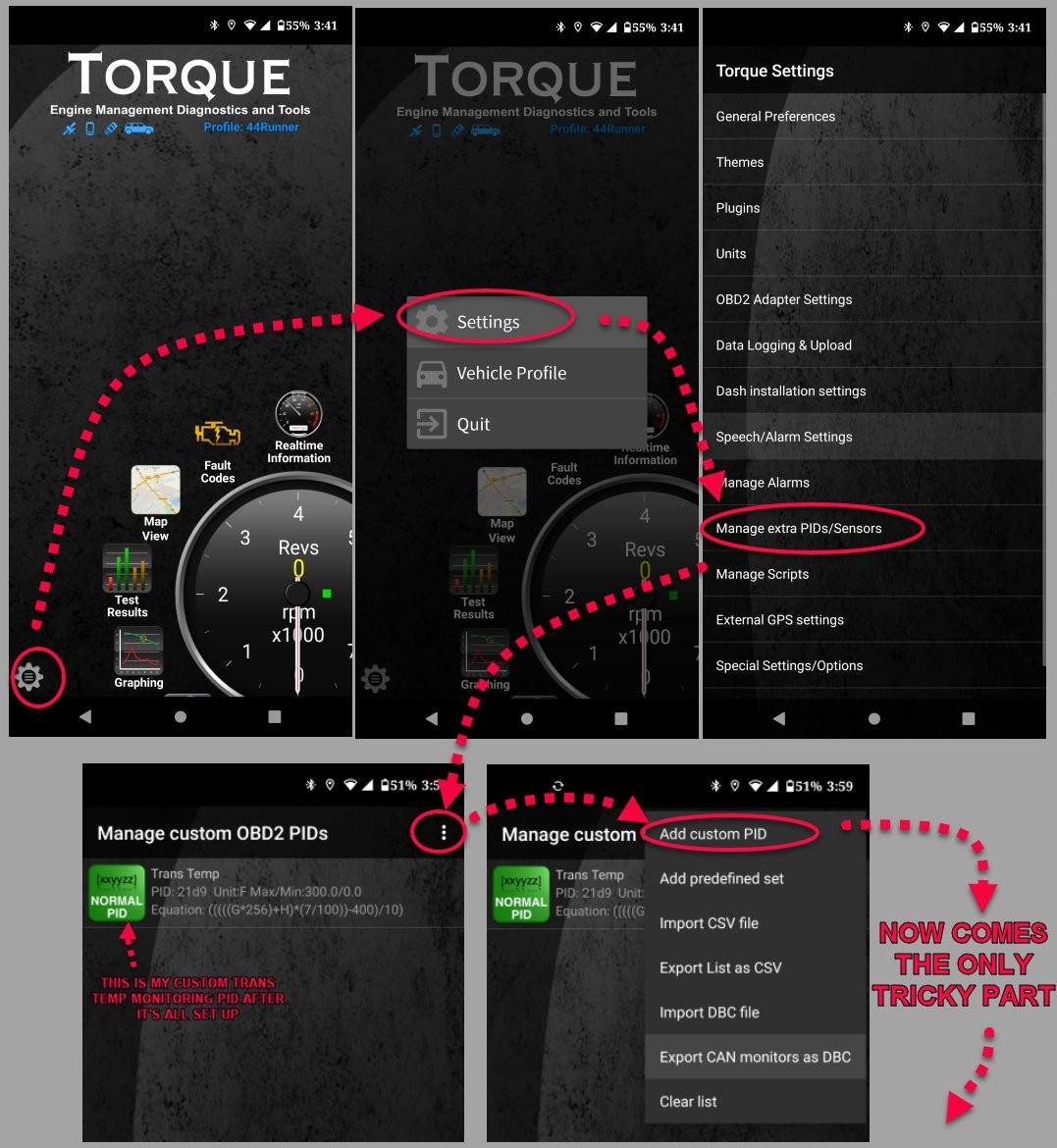 Screenshot of Torque Pro app showing custom PID settings for Toyota 4Runner transmission temperature – Part 1
Screenshot of Torque Pro app showing custom PID settings for Toyota 4Runner transmission temperature – Part 1
Torque Pro app screenshot, part 1, showing the initial custom PID setup screen.
* **OBD2 Mode and PID:** `21d9`
* **Long Name:** (e.g., `Trans Temp`) - Choose any descriptive name.
* **Short Name:** (e.g., `Trans Temp`) - Choose a shorter version of the long name.
* **Minimum Value:** `0`
* **Maximum Value:** `300`
* **Scale Factor:** `x1`
* **Unit Type:** `F`
* **Equation:** `(((((G*256)+H)*(7/100))-400)/10)` **Important:** Ensure you enter this equation **exactly** as shown, with five opening parentheses and no spaces. A green checkmark should appear once entered correctly.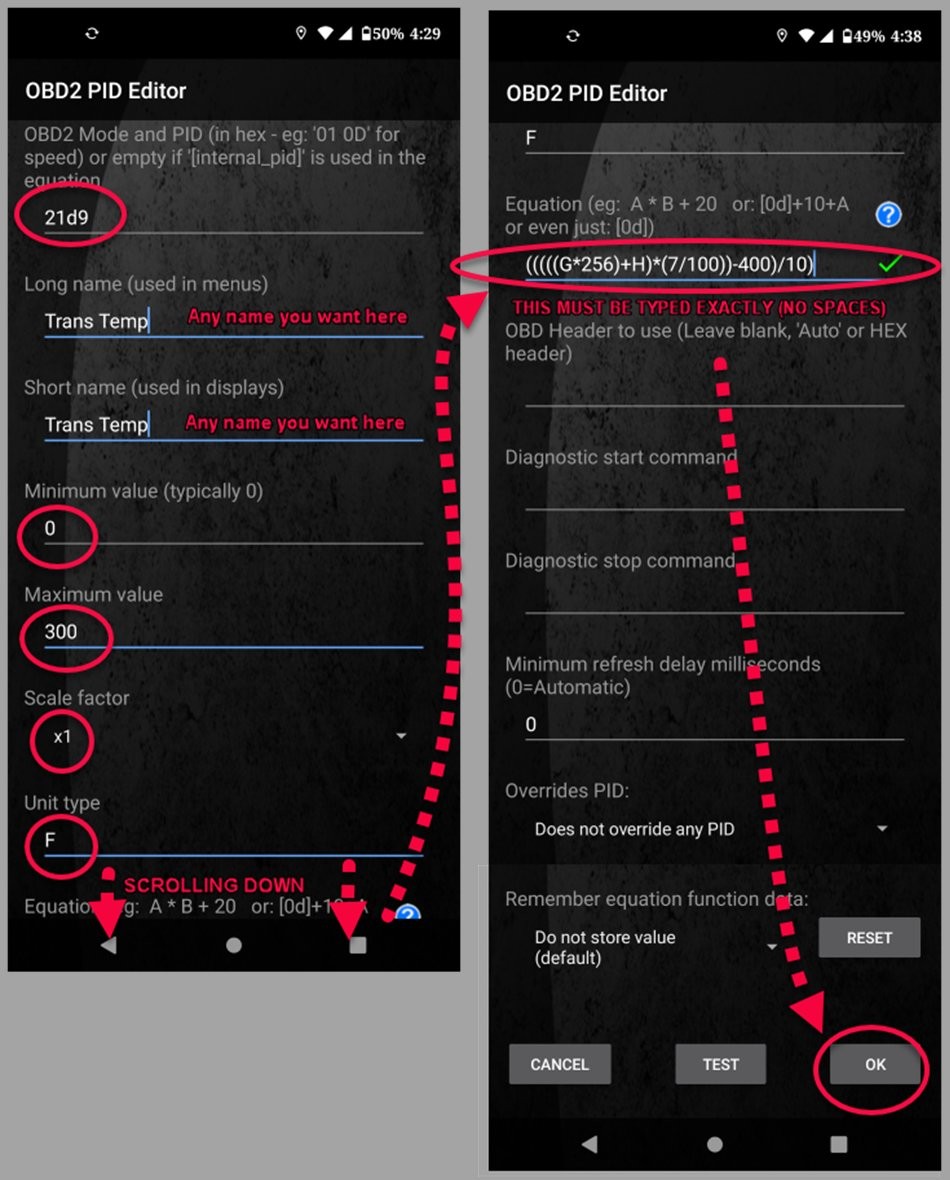 Screenshot of Torque Pro app showing custom PID settings for Toyota 4Runner transmission temperature – Part 2
Screenshot of Torque Pro app showing custom PID settings for Toyota 4Runner transmission temperature – Part 2
Torque Pro app screenshot, part 2, displaying the completed custom PID settings with the equation.
* Tap 'OK' to save the custom PID.- Add Gauge to Realtime Display:
- From the Torque Pro main screen, select ‘Realtime Information’.
- Tap the gear/menu icon > ‘Add display’.
- Choose a display type (e.g., ‘Digital display’).
- Select your newly created sensor (e.g., ‘Trans Temp’ or whatever you named it).
- Choose a widget size. Place the new gauge on your Torque Pro dashboard.
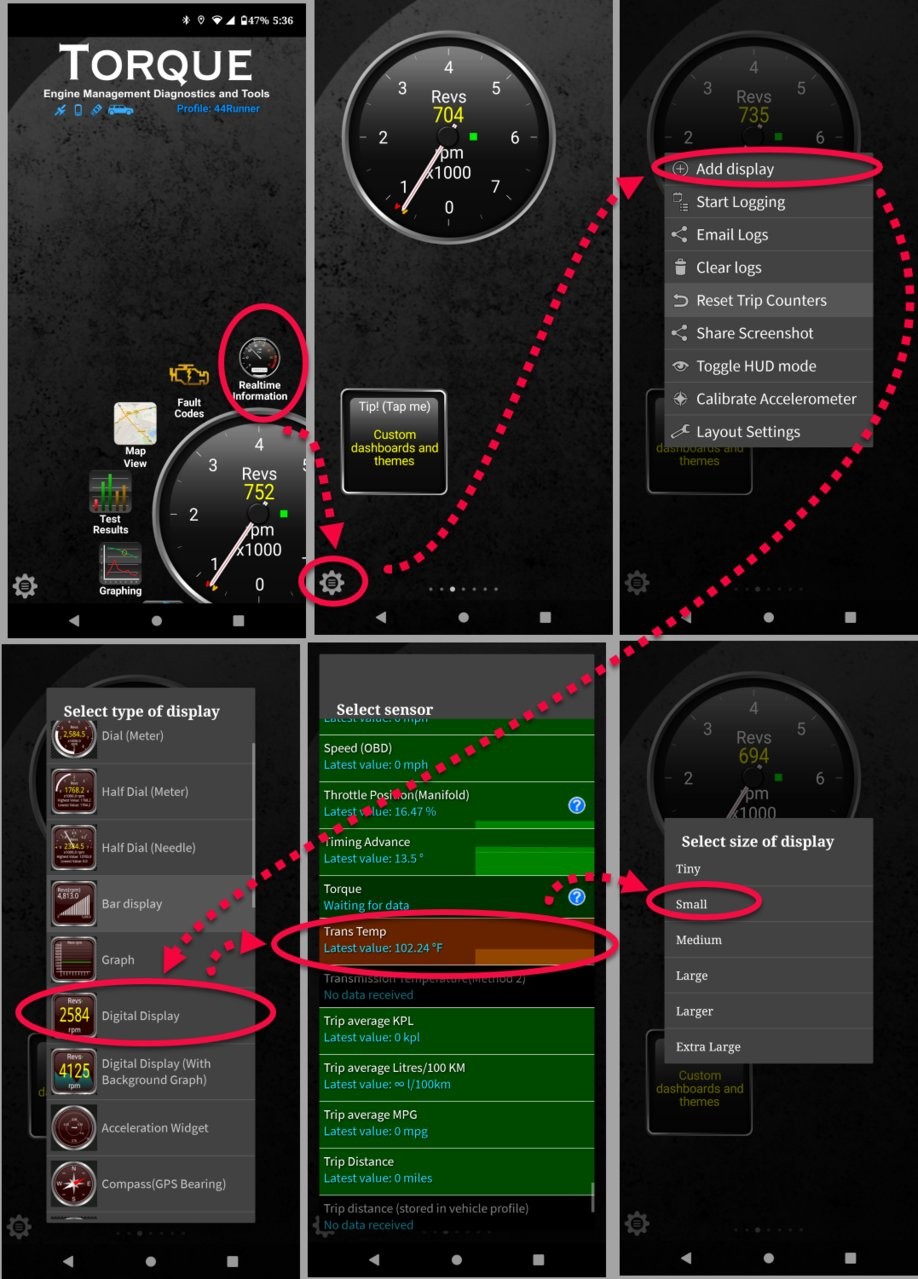 Screenshot of Torque Pro app showing how to add a new display gauge
Screenshot of Torque Pro app showing how to add a new display gauge
Torque Pro app screenshot showing the process of adding a new display gauge to the dashboard.
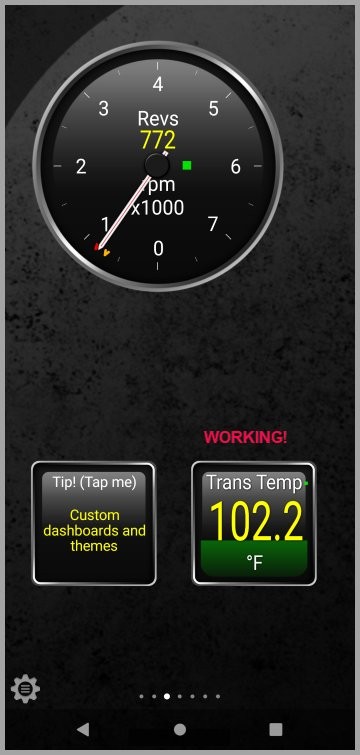 Screenshot of Torque Pro app displaying the newly added transmission temperature gauge
Screenshot of Torque Pro app displaying the newly added transmission temperature gauge
Torque Pro app screenshot showcasing the final dashboard with the newly added transmission temperature gauge.
Now, start your 2009 Toyota 4Runner’s engine, and you will see the transmission fluid temperature displayed in real-time on your Torque Pro dashboard. This method is verified to work on 2007 4Runners and is expected to be compatible with other 4th Gen models from 2004-2009.
Note for 5th Gen 4Runners (2010+): While this guide focuses on the 2009 model, for newer 5th Gen 4Runners (2010 and later), the custom PID data may differ slightly. The OBD2 Mode and PID for 5th Gen models is often 2182, and the Equation may be ((((A*256)+B)*(7/100)-400)/10). Always verify the correct PID and equation for your specific year and model.
Alternative OBD2 Apps: Besides Torque Pro, other OBD2 apps like OBD Fusion can also monitor Toyota transmission temperatures. OBD Fusion may require purchasing the app and then an additional enhanced diagnostics add-on specific to your Toyota model to enable transmission temperature monitoring. This might be a slightly more expensive option but could offer a more streamlined setup process for some users.
Conclusion:
Monitoring your 2009 Toyota 4Runner’s transmission temperature is a crucial step in maintaining its longevity and performance. While the paperclip method offers a free solution, it is less convenient for regular checks. Utilizing an OBD2 adapter and the Torque Pro app provides a more user-friendly, real-time monitoring capability, making it easier to stay informed about your transmission’s health. Whether you choose the paperclip method or invest in an OBD2 setup, regularly checking your transmission temperature will contribute to the reliable performance of your 2009 Toyota 4Runner for years to come.
